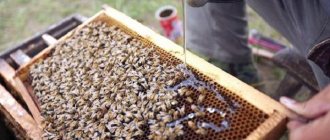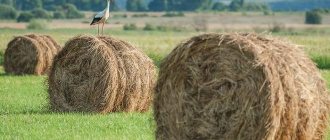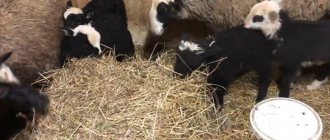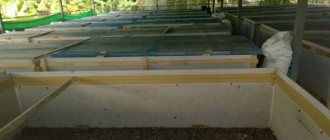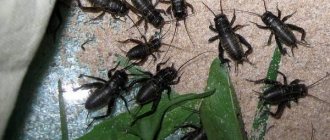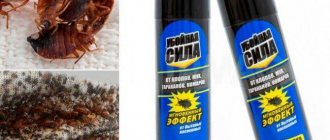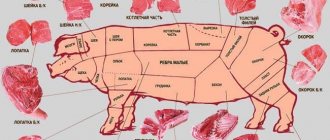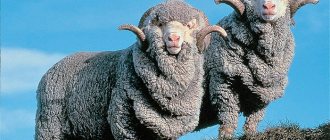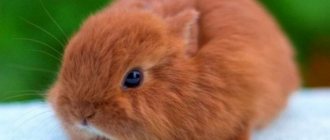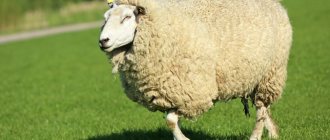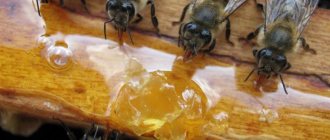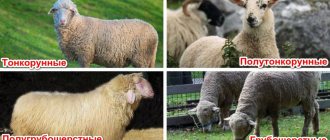- Wintering bees in the wild
The winter period in our country is unpredictable and rich in all sorts of unpleasant “surprises”, so wintering bees requires thorough preparation and significant effort on the part of the beekeeper: any unforeseen “little thing” can become a serious test or even cause the death of a bee colony.
Winter time, at first glance, gives the beekeeper an opportunity to take a breath while the bees sit in the streets and wait for spring, but one should not relax - one must keep everything under control
How do bees winter?
In autumn, hardworking insects move from the active period of life to a state of rest. In the last days of the season, bees fly around only to empty their intestines. The body structure has the peculiarity of increasing, accommodating an average of 40 mg of feces. Special substances stop decomposition processes. The body's metabolism slows down, which allows you to survive the winter safely.
The food is also designed for a slight intestinal load. Which helps to successfully overcome the harsh winter. Excessive energy expenditure wears out the body. They may not live to see the new season.
With the first coolness of autumn, beekeepers take care of grouping workers on honeycombs with food. When the temperature drops to eight degrees, they move to the winter club. Strong families maintain the required temperature both in the center of the club and on its surfaces. A weak family concentrates heat on the shell. Bees work with redoubled force, expending energy and food, overloading their intestines.
In any wintering option, the bees are kept at rest, without being subjected to unnecessary influence. Particular sensitivity appears at the end of wintering. Provoked flight in cold weather guarantees bee diarrhea in the hive.
Coming out of the winter hut begins with the air warming up to twelve degrees Celsius. Evolution in different climatic zones has developed resistance to the characteristics of natural phenomena. Therefore, local breeds winter safely in their native lands.
What and how to feed bees?
First of all, bees should receive natural honey, but if there is not enough of it or it is of poor quality, the food is replaced with other food.
Sugar syrup
This food does not contain vitamins and microelements, but it is possible to maintain the vitality of bees. In addition, it will warm the hive.
How to cook:
- Use enamel cookware, but not iron, to prevent oxidation.
- Pour in 2 liters of water, boil for 5 minutes.
- Remove from heat and add 3.5-4 kg of sugar.
- Stir thoroughly until the sugar is completely dissolved.
- Cool until warm.
- Add vinegar essence (approximately 1.2-1.3 ml per 4 kg of sugar), but this is not necessary.
Feeding rules:
- For 1 hive per day you need approximately 5 liters of syrup.
- Feeding time is evening.
- The state of the syrup is warm (hot and cold are excluded).
- If the bees are completely restored, the dosage is reduced to 300 ml.
- The hive must be well ventilated, otherwise condensation will be created, leading to a deterioration in the condition of the insects.
Syrup with potatoes
By adding potato juice, you can significantly improve the composition of the syrup, saturating it with useful substances.
Cooking method:
- Peel the potatoes, rinse thoroughly;
- pass the tubers through a meat grinder or grate on the finest grater;
- squeeze out the juice;
- For 1 liter of sugar syrup, add a maximum of 60 ml of juice;
- Dilute components only when warm.
How to feed:
- tie the container that you will place in the hive with gauze;
- pour the mixture into this glass container;
- put in the hive;
- Make sure that the bees not only drink the juice and syrup, but also eat the starch residue.
Dough made from sugar and honey
This recipe is used as a top dressing. Used and prepared as follows:
- take 4 kg of granulated sugar, grind it with a blender to powder;
- put a kilogram of honey on the fire (it should become liquid and warm);
- add powdered sugar, stir;
- achieve dough consistency;
- add 100 ml of water;
- make a flat cake 2 cm thick from half a kilogram of dough;
- place the dough on the frame.
Fertilizing with beebread
You can feed beebread in 2 ways:
1 way
Bees place bee bread on the sides of the brood, that is, on the edge of the honeycomb. When the pollen flow is in full swing, you need to remove these honeycombs and install frames with foundation in their place.
And the beebread elements are installed in another housing, which will allow insects to fill them with honey and seal them.
After this, take out the frames and place them in boxes, the temperature in which should be from 2 to 8 degrees. At the beginning of spring, feeding is carried out (when the bees need to gain strength).
Method 2 - preserving beebread
It is necessary to remove the surface of the cells on which there is beebread with a sharp knife. Next, they are cut and passed through a meat grinder. Afterwards, wash the glass jars and dry thoroughly.
Place beebread in them and fill them with honey. Roll up in the usual way. When feeding is carried out, the jars are placed in warm water so that the mass melts and becomes homogeneous.
Place 300-400 grams of the product on polyethylene, which is turned over onto the frames and left as insulation. You can repeat fertilizing after 7-10 days.
Preparing bees for winter
In autumn, preparations for winter begin with the end of the season and a drop in temperature. The insects stocked up on their main food - honey and beebread.
Bribes are gradually being reduced. Then egg laying stops completely. The final sowing is carried out in the very center of the warm part of the hive from the south. After the brood emerges, the empty cells are filled with food. Bees independently eliminate cracks with propolis, reducing the size of the entrances. Overwinter:
- uterus;
- young animals;
- some adults.
The drones are expelled at the end of the honey harvest. Until the next season, they do not participate in the life of the family. Insects consume food rationally, so it is not advisable to feed drones.
The guarding of the entrance to the hive ceases, moving to the center. Wintering takes place without flights, so it must be done on the last warm day. This is the last time the insects defecate for the season. As the temperature drops, the activity of bees fades away. A club is formed, adjacent to each other.
When preparing for wintering, it is important to take into account the characteristics of the breeds. For example, Karnika is adapted to frosty conditions and variable winds. They winter in small families. For the Carpathians, family unification is practiced.
Treatment of bees and hives against diseases
Bees are quite often exposed to diseases that can lead to their death during wintering. Therefore, it is important to treat insects and hives in preparation.
This is done after the last brood has appeared and the nest has formed. The most common diseases are nosematosis and varroatosis.
There are different processing methods:
- Complementary feeding with medicines. That is, the appropriate medicine is injected into the liquid food (preferably sugar syrup). Bees eat it along with their food. The veterinarian must choose the drug based on the expected disease, although there are universal remedies. For nosematosis, Fumagilin proved to be effective, and for varroatosis, Apimax.
- Smoke cannon. To do this, smoke is introduced into the hive, closed for 20 minutes, and then opened. The downside is the need to carry out the procedure twice. Today there are special preparations that treat the hive thermally using a special gun. You can fumigate hives with Folbex, Phenothiazine, Bipin.
- Liquid vapor. To do this, you need to hang a plate in the hive, onto which a liquid product is first applied. The bees touch it and spread the drug throughout the hive, creating a chain reaction effect. Or vapors are released from the plate, which the bee absorbs through the respiratory tract. Products: Nosemaline, oxalic acid.
Smoke cannon treatment
Some chemicals have a negative effect on the family. Therefore, choose products based on natural ingredients.
What do bees do in the hive in winter?
In overcoming the cold, bees independently prepare for wintering. No need to worry about greenhouse conditions. Nature has developed its own methods during evolution.
All individuals unite in a single club to maintain warmth. There is a constant movement from the top of the club to the inside, pushing out those who have warmed up and stocked up on food. The lower the temperature, the higher the activity. The club moves to the top, to the back walls in search of food. The heat in the core rises to thirty degrees. At the edges up to fifteen degrees.
Shelter in sunbeds
The shelter in the sun loungers is based on frames, which makes more efficient use of the space on the sides and optimizes the service. The beekeeper can install additional structures in the hives with this method of organization. The frames are taken from Dadanov and Ukrainian. The latter are a more profitable option, because the food is located in a vertical plane: this makes it more convenient for the bees to receive honey. Dadanov frames are smaller in height and therefore not so convenient to use.
Preparatory work to create a beehive for wintering in an apiary begins in the fall. The beekeeper stores food and checks the fertility of the queen bee. The walls and ceiling are insulated with polystyrene foam adjusted to size, leaving a gap of 5 mm to ensure moisture circulation for the hive.
Preparing a beehive for wintering in an apiary
Why do bees die in winter?
Mortality is influenced by various factors, including poor wintering. The right content will help minimize or completely eliminate:
- weak families;
- death of the uterus;
- hunger;
- high humidity;
- low temperature;
- diarrhea;
- illness;
- rodents.
Excessive moisture is determined by the presence of mold. The main factor is insufficient ventilation of the omshanik. Improper treatment against diseases also increases humidity levels.
The formation of excess moisture leads to souring of honey. The consequences are the death of insects due to hunger. There may be a shortage of food due to crystallization of honey and cold.
A common consequence of death may be bee diarrhea. When brood appears in the last months of autumn, proper flight does not occur. A large amount of feces accumulates. A full intestine of young individuals leads to pestilence of the entire family.
Honeydew honey can also cause diarrhea. Honey varieties with the highest content of active ingredients are not suitable for eating during the wintering period. These include all varieties of dark colors. It crystallizes and sours faster.
The absence of a uterus is another pestilence factor. When the bees search for the queen, the state of the club is disrupted. The insects can no longer gather again, and a steady death occurs.
Smooth death is caused by increased temperature in the house, eight degrees or excessive noise and bright light.
The slide-shaped podmor says that the bees were not warm enough, and the cause of death was starvation. While moving for food, several small tubers may form.
The cause of bee death is infectious and invasive diseases. Some of them:
- viral paralysis;
- salmonellosis;
- calcareous, sacbrood;
- rotting larvae.
When eliminating diseases, special treatment is carried out. It is necessary to combat pathogens correctly so that this does not become another reason for the death of bees.
Feed supplies
The beekeeper stocks up plenty of honey for the winter so that the bees do not starve. It is better to take more of it than required than not to take enough: there is no need to fear that the flock is in danger of overeating, because each bee consumes exactly as much food as it needs.
For wintering outside (if a multi-body nest is installed), honey reserves are made in a volume of about 45 kg. Supplies are placed in the upper part of the nest, where the inhabitants of the hive will fly up from below. A convenient option is a two-tier structure in which the bees can move unhindered.
In nest-beds, the preparation of supplies in winter is calculated based on the number of frames: about 2.5 kg of honey, syrup and beebread for each.
Nutrition of bee colonies in winter
In winter, a family’s food consumption is 18–25 kg of honey. The food is pre-sealed for safe storage. The bee club gradually moves upward, eating supplies. At the same time, free sealed honeycombs are occupied. It is advisable to select frames in dark shades.
Feed consumption depends on the quality of the hive. Warmth, low humidity and high-quality ventilation guarantee minimal consumption. A strong family is able to independently make the necessary amount of supplies for the winter. Harvested honey is stored in a thick form. Insects disperse it with specific glands. The necessary moisture is taken from the steam released during breathing. Excess moisture spoils the honey, causing death.
During winter, bees do not defecate when consuming high-quality fodder honey. Crystallized or sour food causes diarrhea and nosematosis, which is detrimental to the entire family.
Weak bee colonies require more food to maintain warmth. Wintering is better tolerated if there is a young queen in the hive.
Bee food:
- honey;
- honey is full;
- syrup;
- powdered sugar;
- honey;
- protein feeds.
Syrup is the most economical food. No additives, but also no protein.
Useful tips for beekeepers
Every experienced beekeeper can share with a novice beekeeper his tricks and secrets, thanks to which the bee colony will successfully overwinter.
Here are some of the recommendations:
- Be sure to insulate the hives. A variety of materials are used for this. Most often, to save money, beekeepers take improvised things - foam sheets (left over from household appliances), plastic films, polyurethane foam, old bags, warm clothes, straw and much more.
- To better maintain warmth in winter , all hives are moved to each other, that is, grouped. If you place them very close, there will be no open walls for the wind to pass through. And you will have to use less insulating material (either several hives are covered separately, or one structure, albeit a large one).
- Bee houses are insulated not only from the outside, but also from the inside. To do this, insulating frames are installed on both sides of the club, and warm fabric or any insulating material is placed on top. Straw, felt mats or leaves are placed under the glue.
- The outer side is upholstered with suitable material. For this, small nails and glue are used.
- In the autumn, feeding is necessary , so that the queen will not lose its functionality, and the working individuals will remain active.
- If you add vinegar to sugar syrup , then strictly monitor the dosage, since an excessive amount of acid leads to underinfusion of the sweet mass. As a result, sealing does not occur.
- The relative humidity in the hive should be between 70 and 75%.
- Avoid drafts. If the apiary is located in an open space, then the hives should be insulated with materials that do not allow the wind to pass through.
- Before installing the hives, thoroughly dry and ventilate the areas.
- During the autumn inspection, make sure that the uterus is alive and ready to produce offspring. A cause for concern is the lack of brood and eggs in the combs.
- If the bees are exhausted after the last honey plant , be sure to increase their offspring.
- When the autumn is very hot, it is important to artificially create unfavorable weather conditions for the bees. To do this, provoke a draft or shadow by opening the hives. Because bees replace themselves before wintering. If this does not happen, they will remain unprepared and will have difficulty surviving the winter.
- Strong families are placed at the bottom , weak ones, as well as nuclei with additional queens, at the top.
- Entry holes are allowed to be opened after the members of the bee family have completely calmed down.
Wintering without insulation
Sometimes beekeepers prefer to overwinter bees in a cool room. For wintering bees in omshanik, buildings made of above-ground, combined or underground wood are suitable. Insulation can be made of boards, clay or straw. Good ventilation is needed to bring in fresh air. A solid floor and strong walls retain heat.
In the absence of a special structure, for wintering bees it is suitable to keep them in:
- barn;
- greenhouse;
- basement;
- cellar;
- dressing room;
- shelter in a hut.
Wintering bees in a polycarbonate greenhouse in an area with mild frosts but heavy rainfall. The disadvantage of the structure is considered to be spring temperature changes. To avoid overheating, in the fall the greenhouse is covered with roofing felt.
The inside of the greenhouse is insulated with polystyrene foam using polyurethane foam. Compliance with the requirements ensures that the family remains strong and reduces feed consumption.
A fairy tale about a bee for kids
A fairy tale by Abdullah Alisha called “Nechkebil” will be a good help in these classes. After reading the text, you can invite the kids to draw pictures about what they liked most or remembered from what they read. An adult can also ask questions:
- Why do bees die after they sting someone?
- Why do bees sting?
- Why didn't the bees sting the beekeeper?
- Why was the main character of the fairy tale called Nechkebil, which translated means “thin waist”?
How to properly insulate hives
To insulate hives, selecting the necessary material is important. You can always have at hand:
- straw;
- sackcloth;
- Styrofoam;
- polyethylene;
- worn out warm clothes;
- polyurethane foam insulation;
- other material.
Nests are grouped in one place, reducing the number of walls that are blown through. For insulation inside, frames are used. A denser insulation is placed on top.
External insulation is carried out by sheathing using nails. It is enough to glue the foam to the walls of the house. Felt mats, straw or fallen leaves are placed underneath.
It is important to remember to have adequate ventilation. At elevated temperatures, insects are overly active. The entrance is left open. In severe frost it closes, leaving only a few small holes. You can make two tap holes, but you cannot open them completely at the same time. Adjustment of valves is provided.
Insulation and ventilation of a bee nest
These are essential procedures, since the cold can kill entire families at once, and the lack of ventilation leads to dampness. Dampness is very harmful to insects.
The walls of the hive become damp and mold may appear; due to increased humidity, the honey may sour. Bad honey causes diarrhea in bees. After this, wintering usually ends very sadly, up to complete death, or the bee colonies emerge in the spring very worn out and will not be able to fully develop.
Insulation is carried out using wooden diaphragms or other insulation materials (moss, tow, straw). Many beekeepers use insulating pillows.
The most effective method of ventilation is considered to be ceiling ventilation. Ventilation can also be enhanced by either opening the entrances from time to time or keeping them open throughout the winter. It is advisable to ensure that the nest is ventilated from different sides; for this, you can install a metal grille in the bottom of the hive.
Important! When using any type of insulation, remember that it is equally important to ensure proper ventilation!
How bees overwinter in a hive in an apiary
During the wintering process of bees of autumn generations, the body accumulates nutrients in the form of proteins, fats, and glycogens. The content of free fluid decreases, the type of metabolism of the body changes.
In autumn, with the onset of cold weather, bees form a winter club. At first it is quite loose and can disintegrate under the influence of positive daytime temperatures. Resilience comes with cold weather. The density of the club increases and lasts throughout the cold period.
Wintering bees in a hive involves forming a winter club in order to save food and maintain the required temperature.
How do insects prepare for the wintering process?
As mentioned above, bees begin preparing the nest in the fall. Insects prepare excess honey for nutrition and store it in the upper honeycombs of their hives. At the end of summer, bees intensively collect nectar and seal it in honeycombs so that it does not ferment during storage.
The worker bees then expel the drones from the hive. They simply drag them to the bottom of the hive, where they weaken and then die without food. Then the bees lift the drones and drop them to the surface of the earth. This unique natural behavior allows you to significantly save food supplies for the winter.
After preparing supplies and getting rid of drones, the bees carefully cover all the cracks in the hive with a special substance called propolis. By the way, in Rus' they even determined the weather from bee houses. If the bees covered the hives with propolis too thoroughly, then the winter will be cold and very harsh. Bees prepare their shelter by clearing it of dust particles, small debris and grass. Every day they become less and less active, and with the onset of frost they completely intertwine into a large ball.
Features of bees wintering outside
Preparing a hive for the winter outdoors differs for different climate zones. In the southern regions, free wintering does not require excessive insulation. Which is completely the opposite for the north of the country.
Options for wintering bees outside under the snow are more often used by experienced beekeepers. It is important to eliminate the gaps, insulate them in the fall, and cover the hives with snow. Wintering bees outside in central and northern Russia is impossible without insulation.
First, beekeepers check the protection of the houses from strong winds. Shields can be trees, buildings or fences. In the absence of protection, the walls are insulated with roofing felt and slate. The walls and bottom are insulated. The entrances are covered with shields.
During wintering, healthy, strong individuals hatch in hives under the snow. The early flight begins. It is important to take into account that the snow masses do not lie close to the houses and do not fall into the entrances. During the cold season, bees outside in winter eat several kilograms of food more than in the omshanik.
Basic methods of winter maintenance
There are many ways to keep bee colonies in winter. The choice of one or another of them depends on climatic conditions, quality of feed, condition of the hive, etc. If winters are long and with bitter frosts, then the best option would be to place them in a winter hut. If the climate is mild and allows insects to even make winter flights, then many beekeepers leave them in the wild - in a “cold” wintering area. It is more advisable to use the method that, at the lowest cost, will allow the bees to be preserved in a given area for the new season.
Wintering bees in the wild
In the southern regions of Russia (Kuban, Rostov region) and Ukraine, bee colonies are often left to overwinter directly in the open-air apiary.
In regions with mild climates, evidence is left in the apiary without being brought indoors
Supporters of cold wintering of bees argue that a strong colony can easily overwinter in the wild and this will only benefit it. Such insects swarm less and are more productive. The flyby occurs on the first fine sunny day a month before the standard dates, or even earlier. This is important because, having cleared themselves of feces, the bees begin to actively grow brood and by the time of the usual exhibition from the winter hut there are 4-5 frames with brood in the nests. It is to feed it that 2-3 kg of “extra” honey is consumed, which is eaten during wintering in the wild.
For this method you need:
- insulate the nest, put a store on the ceiling, place pillows and dry moss in it. Place the hives on stand boxes 30-40 cm high with dry leaves and moss (this measure will help increase the temperature inside the housing by 2-5 ℃). Many beekeepers recommend using car tires as a stand. In this case, the upper entrance is open all winter, providing air flow and the opportunity for bees to fly around during the thaw;
- provide insects with high-quality food;
- have a sufficient number of young individuals;
- eliminate factors that may cause concern to the bees - cover the barriers from rain, snow or wind getting into the hive.
If the winter is snowy, it is advisable to rake up the snow and fill the hives with it from the back and sides to the very cover, from the front to the middle. If frost hits, it is advisable to completely cover the hives with snow. Snow cover will help reduce the energy costs of bees to maintain the optimal temperature in the nest and, accordingly, reduce food consumption.
Covering with snow allows air to pass through and helps maintain a more even temperature without sudden changes.
In winters with little snow, it is necessary to compensate for the lack of snow with straw, roofing felt, synthetic insulation, etc.
Wintering in a winter hut
During the cold season, most beekeepers move hives with their inhabitants to specially built or adapted above-ground or semi-underground winter huts - closed, unheated rooms. This makes it possible not to depend on weather conditions, the presence or absence of snow, frost and other factors. Typically, hives are placed in a winter hut in the first half of November, when the average daily temperature drops below zero.
Stronger families should be placed on the lower shelves, closer to the door. It is better to place one of these hives on a scale to control feed consumption during wintering
You need to visit bees in the winter hut in December and January no more than 2-3 times a month. This is a dormant period that lasts until the brood appears. Insects behave quietly, honey consumption is 750-900 grams per family per month . In the pre-spring period, in February, life activity in families intensifies and requires more constant monitoring - at least once a week.
During inspections, it is important to pay attention to the condition of the dead. With its help, you can promptly detect negative manifestations of wintering, find out the causes of problems and take appropriate measures. At the end of February, insects in the club, in connection with raising offspring, raise the temperature in the nest to +35 ℃ and begin to consume more food. This leads to faster filling of the abdomen with excrement.
Temperature and humidity adjustment
Controlling the microclimate in the winter hut is extremely important for the successful preservation of the bee colony. The optimal indoor temperature should be +2…4 ℃ . Its decrease to minus levels (−4… −5 ℃) has an extremely unfavorable effect. In such cases, water vapor in the hive (the bee colony releases over 5 liters of water), settling on the walls and ceiling, begins to turn into frost, which melts with warming and increases humidity. The usual air humidity in the winter hut is from 75 to 85% .
Both excessive dryness and excessive amounts of moisture can be detrimental to insects.
If the air is dry, the crystallization of honey accelerates; if it is too humid, mold appears on the combs, the food liquefies, its fermentation may begin, which, in turn, threatens diarrhea, and can also provoke early activity of bees in breeding new brood.
In the photo - a psychometric hygrometer with two temperature scales
To determine the temperature and humidity of the air in a room, a traditional psychrometer is used - a special device consisting of two thermometers - dry and “wet” (moistened in water), as well as a hygrometer, which allows you to measure the humidity of solids.
If air humidity is less than 70%, it should be artificially increased: spray the walls and floor with water, hang wet burlap. If the indicators exceed 90%, it is necessary to increase the ventilation of the room (but prevent drafts) or install baking trays with quicklime (a layer of 25-30 mm), which can absorb moisture well.
If the preparation has been carried out at the proper level, then special care for bees during the winter months is not required. You can safely use the freed up time at your own discretion: repair old or build new hives, make frames, assemble spare buildings, and also improve your skills - exchange experiences with colleagues on forums for bee lovers, read specialized literature, watch videos.
Checking bees
If proper preparation for wintering is observed, it is not necessary to disturb the hive. Many beekeepers still make the rounds with the basic rules of inspection:
- The clubs are located taking into account free passage between the hive.
- The covers are carefully removed, preferably in calm weather.
- Cabins are not checked in clear weather. A cloudy, cloudy day is preferable.
- A monotonous buzzing sound in the hive signals the good condition of the colony.
By adhering to the simple rules of beekeepers to create favorable wintering conditions for bees, insects will endure any weather conditions. And already in early spring, the overwintered family will begin to bring a lot of valuable sweet product.
Basic mistakes
An experienced beekeeper has already derived from his own experience the main rules for preparing bees for wintering. However, novice beekeepers may not take into account some circumstance that will cost the life of the bee colony.
Their main mistakes are:
- Pumping out all the honey . A family cannot fully develop on syrup alone. Honey is especially needed in the spring, when the first brood is hatched;
- Overfeeding with syrup. This circumstance follows from the first mistake. In an effort to compensate for the lack of food, bees intensively process syrup, which leads to their exhaustion;
- Inaccurate feeding. Syrup spilled around the hive and on it provokes theft and even a bee war, in which many bees die;
- Late feeding . If reserves have already been made, young bees are preparing for winter, then feeding only depletes their fat body, and they go into winter weakened;
- Lack of bee bread. When the spring brood emerges, there will be nothing to feed it;
- Leaving light honeycombs. Brood did not hatch in such combs, and they do not hold heat well. Bees freeze on such honeycombs and consume a lot of food;
- Early insulation. It can provoke incorrect formation of the club, as a result of which the bees will freeze;
- Incorrect position of the hive . The bee house should be slightly tilted forward to prevent moisture from flowing into the entrance and the formation of dampness inside.
Possible problems
To preserve bees in winter, it is important to provide them with favorable conditions. At the same time, beekeepers often face the following problems:
- Feed shortage. In order for insects to survive the winter normally, they need to be fed properly. It is important to use food of proper quality. Light varieties of honey are most suitable for wintering - for example, linden. Dark varieties crystallize quickly, and therefore bees cannot eat such food.
- Violation of ventilation. Insufficient ventilation leads to nests becoming damp. Wet frames and mats cause the nest to cool down. This entails an increase in feed consumption.
- Development of diseases. Initially, a sick family should not go for the winter, as the situation will worsen. The most common disease is varroatosis. Infected bees are characterized by restless behavior, wear out, consume a lot of food and die.
- Weakness of families or lack of individuals. A weak bee colony will not be able to survive the winter. Only strong individuals are resistant to survival conditions. In addition, caring for young individuals is of great importance. It is important that in the fall there are at least 3 frames of brood in the hive.
Wintering of bees is considered a fairly important stage of their life. For it to be successful, it is important to provide the insects with suitable conditions and feed them correctly.
Features in different regions
The climatic conditions of the area greatly influence the organization of how to prepare bees for wintering outside. Features of preparation:
- Ural. It is a mistake to believe that it is worth putting the flock into shelter early. Bees in these parts do not have enough sun, so before wintering they need to be allowed to fly in the air, and only in the second half of November they should be sent into the warmth. Honey for reserves is taken from acacia or white clover. The Urals are characterized by dampness, so the beekeeper is obliged to monitor ventilation so that the bees do not get sick. The hives should be dark and cool.
- Kuban. Here sometimes there is a sharp thaw (even in January), and in the conditions of insulated hives the queens will begin to bear fruit early, the immunity of the whole family will be at risk. Housing must be adapted to environmental conditions; ventilation plays a major role here. Kuban bees are given exactly as much honey as required - no more. They are also protected from rodents.
- Siberia. Work on thermal insulation, frost protection and sufficient food supplies.
- Northwest. The emphasis is on insulation and protection from dampness. Winters here are long. The structures for this zone are single-walled frame structures. Thermal insulation material must have a high thermophysical level.
- Moscow region. The requirements for bee wintering are as follows: timely snow removal, absence of wrapping coverings and ventilation through the upper entrances. A strong family must be provided with sufficient free space and many entrances, while a weak family must be provided with a lot of food.
When is feeding needed?
Bees feed on honey, powdered sugar, syrup, and protein feed. Strong families prepare their own supplies. To keep the food fresh, the cells with it are sealed. Before absorption, bees mix honey with the secretion of special glands.
On average, insects eat 18-24 kilograms of honey. This amount is enough for one bee colony. Food consumption is influenced by many factors - temperature, ventilation, humidity. The better the conditions, the less feed is required.
